Huai Kha Khaeng Wildlife Sanctuary
| Huai Kha Khaeng Wildlife Sanctuary | |
|---|---|
| เขตรักษาพันธุ์สัตว์ป่าห้วยขาแข้ง | |
 | |
Location in Thailand | |
| Location | Kanchanaburi, Tak and Uthai Thani Provinces, Thailand |
| Nearest city | Tak |
| Coordinates | 15°25′05″N 99°13′57″E / 15.41806°N 99.23250°E[2] |
| Area | 2780 km² (after 1992) |
| Established | 1972 |
| Governing body | Wildlife Conservation Office |
| Official name | Thungyai-Huai Kha Khaeng Wildlife Sanctuaries |
| Type | Natural |
| Criteria | vii, ix, x |
| Designated | 1991 (15th session) |
| Reference no. | 591 |
| Region | Asia-Pacific |
The Huai Kha Khaeng Wildlife Sanctuary (Thai: เขตรักษาพันธุ์สัตว์ป่าห้วยขาแข้ง, pronounced [kʰèːt rák.sǎː pʰān sàt pàː hûaj kʰǎː kʰɛ̂ŋ]) is in Uthai Thani and Tak Provinces, Thailand. The park was established in 1974, and is part of the largest intact seasonal tropical forest complex in Mainland Southeast Asia. It, coupled with the Thungyai Naresuan Wildlife Sanctuary was declared a World Heritage Site by the United Nations in 1991.[3] Together, the two sanctuaries occupy 622,200 hectares. As of 2014[update] it still contained viable populations of large mammals, including gibbons, bears, elephants and Indochinese tigers, although like all other sites in mainland Southeast Asia, some species (e.g., rhinoceroses) have disappeared or have experienced severe declines.[4]
History
[edit]After the establishment of the wildlife sanctuary on 4 September 1972, it covered an area of 1,019,375 rai ~ 1,631 km2 (630 sq mi). The wildlife sanctuary was then expanded twice, first on 21 May 1986 to 1,609,150 rai ~ 2,574 km2 (994 sq mi), an increase of 589,775 rai ~ 943 km2 (364 sq mi) and on 30 December 1992 to 1,737,587 rai ~ 2,780 km2 (1,070 sq mi) an increase of 718,212 rai ~ 1,149 km2 (444 sq mi).[5] Until 1976 there were Karen villages within the wildlife sanctuary. Today the wildlife sanctuary no longer has any known human population living in the area. Some Karen villages were moved in 1976 from the southernmost area to Ban Rai District to the southeast. A Hmong village in the west was moved after 1986.[6]
Wildlife
[edit]A large number of the animal and plant life diversity can be found nowhere else, with species such as the Sino-Himalayan, Indo-Burmese, Sundaic, and Indo-Chinese affinities, living in the wildlife sanctuary. Species present at the wildlife sanctuary are usually rare, endangered, or local. Roughly one-third of Southeast Asia's mammals are said to be thriving within the wildlife sanctuary. The wildlife sanctuary is responsible for three of the National Reserved Wildlife Species of Thailand: wild water buffalo (Bubalus arnee), mainland serow (Capricornis sumatraensis), and Indian hog deer (Hyelaphus porcinus). Many species of birds, reptiles, and amphibians have also been reported. Sighting of 355 bird species have been recorded in the wildlife sanctuary, a lot of these species are now rare in Thailand and some are considered endangered.[6] There are currently 90 wild Indochinese tigers within the sanctuary.[7][8][9][10]
Visitor and scientific research facilities
[edit]The wildlife sanctuary receives most visitors during the summer or the "dry season". Some sections of the sanctuary are not open to the public without permission. The Conservation Office in Bangkok and the chief of Huai Kha Khaeng are responsible for granting permission to those who wish to visit prohibited areas.
Location
[edit]| Huai Kha Khaeng Wildlife Sanctuary in overview PARO 12 (Nakhon Sawan) | ||||||||||||||||||||||||||||||||||||||||

|
References
[edit]- ^ "Protected Area Profile for Huai Kha Khaeng from the World Database on Protected Areas". UNEP-WCMC. 2025. Retrieved 2025-01-03.
- ^ "เขตรักษาพันธุ์สัตว์ป่า" [Huai Kha Khaeng Wildlife Sanctuary] (PDF) (in Thai). Retrieved 17 February 2024.
- ^ "Thungyai-Huai Kha Khaeng Wildlife Sanctuaries". UNESCO. Retrieved 11 February 2016.
- ^ Caughlin, T Trevor; et al. (12 November 2014). "Loss of animal seed dispersal increases extinction risk in a tropical tree species due to pervasive negative density dependence across life stages". Proceedings of the Royal Society B: Biological Sciences. 282 (1798): 20142095. doi:10.1098/rspb.2014.2095. PMC 4262173. PMID 25392471.
- ^ Robinnowitz, A. (1991). Chasing Dragon's Tait. New York: DoubleDay.
- ^ a b "About Huai Kha Khaeng". Thai National Parks. Retrieved 12 February 2016.
- ^ Christina Procopiou (19 February 2016). "Endangered Tiger Are Recovering In At Least One Place in the World". Newsweek. Retrieved 19 February 2016.
- ^ "The comeback: Tiger population finally increasing in Thailand". Coconuts Bangkok. 18 February 2016. Retrieved 19 February 2016.
- ^ Platt, John R. (2016-02-19). "Tigers Have Just One Safe Habitat in SE Asia". Scientific American. Retrieved 20 February 2016.
- ^ Elliot, Stephan; Cubitt, Gerald (2001). THE NATIONAL PARKS and other Wild Places of THAILAND. New Holland Publishers (UK) Ltd. pp. 20–25. ISBN 9781859748862.
External links
[edit]- Royal Gazette publications on Huai Kha Khaeng (Thai)


